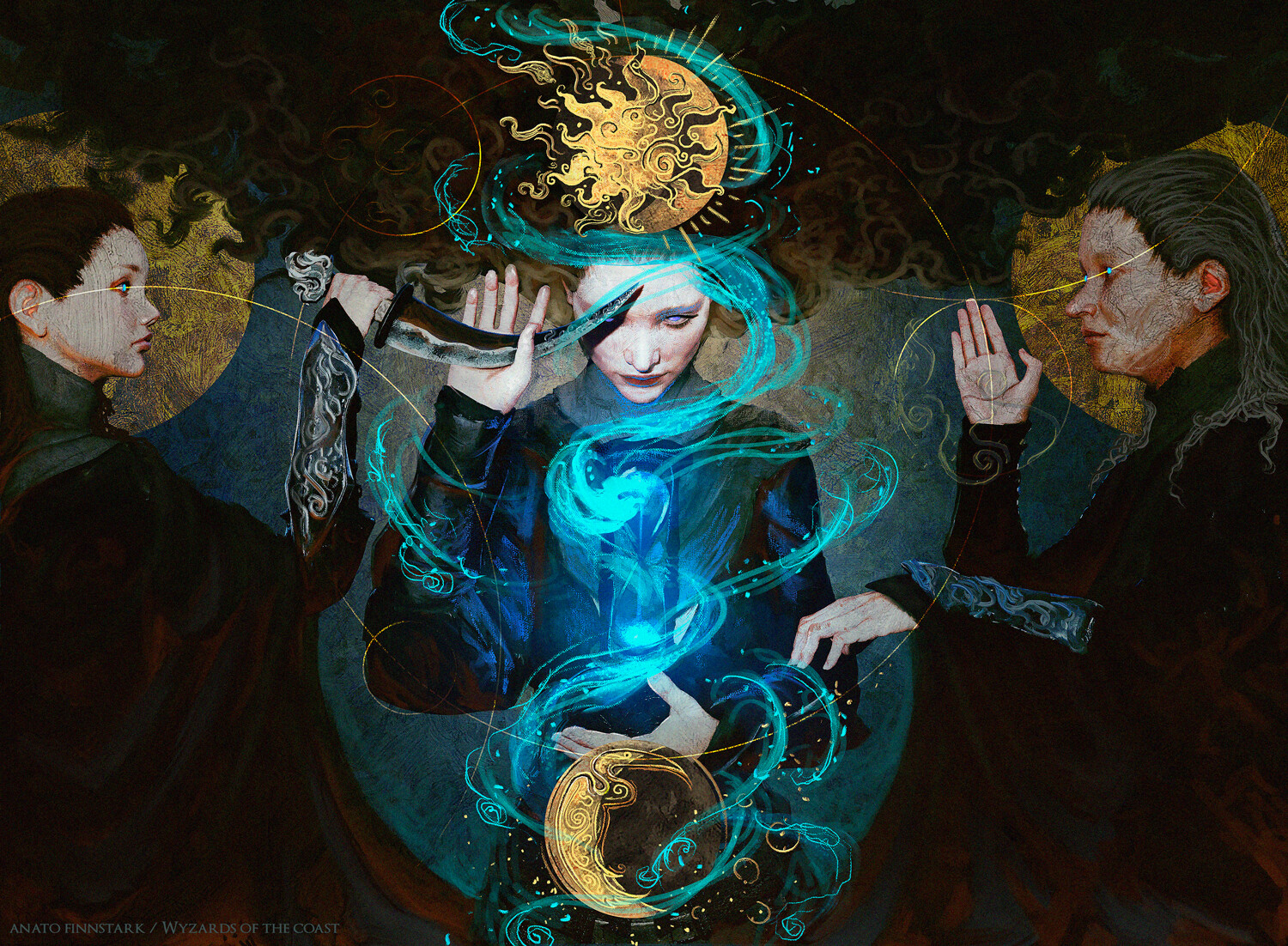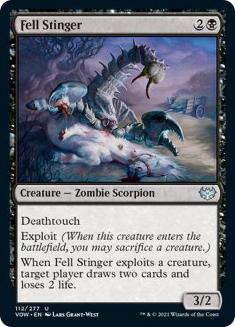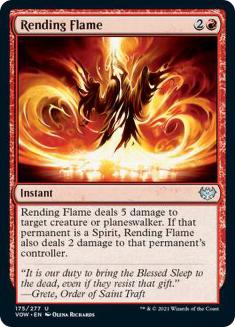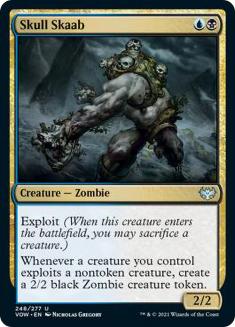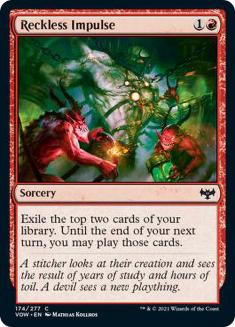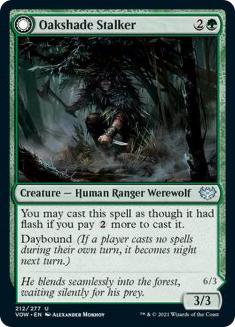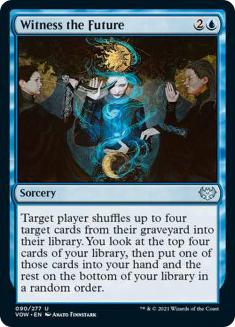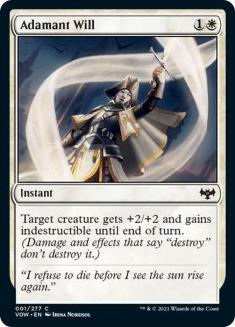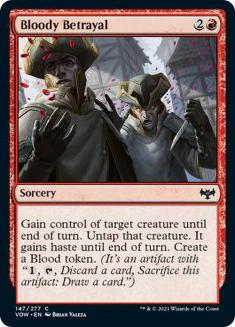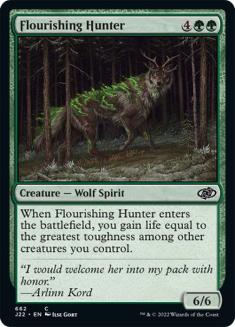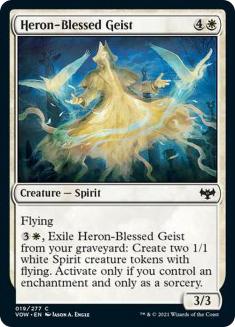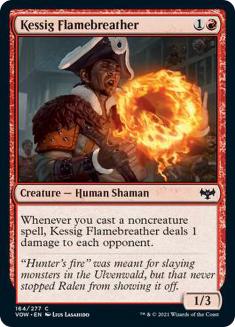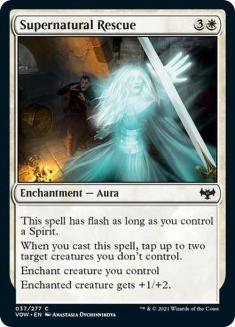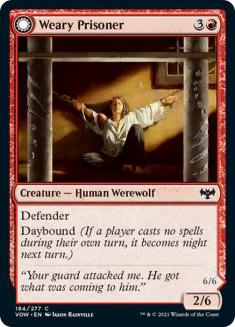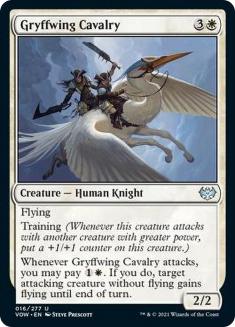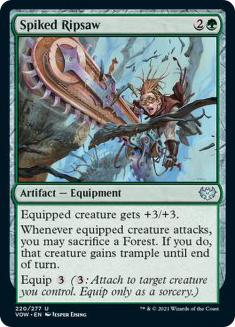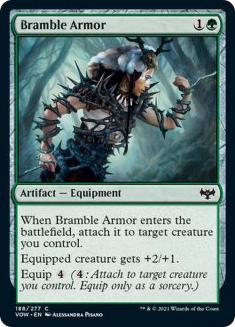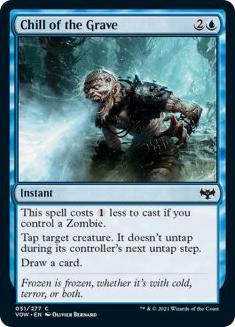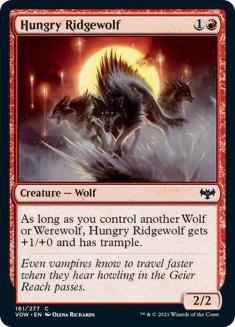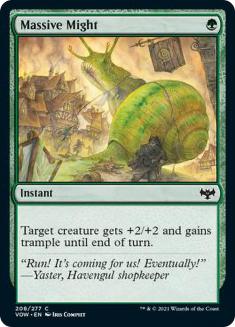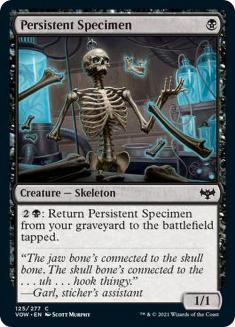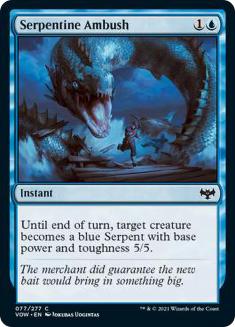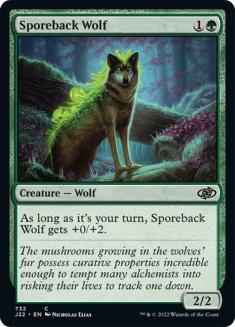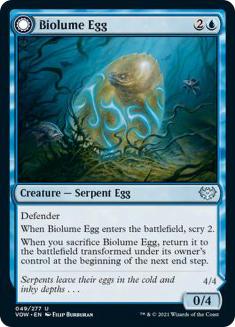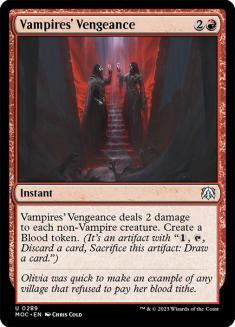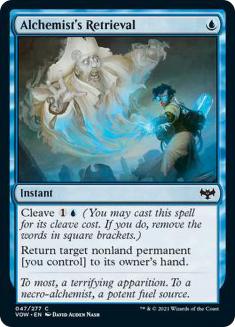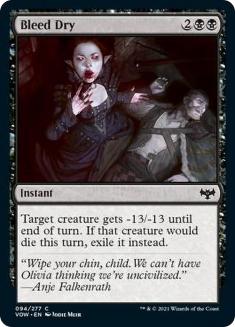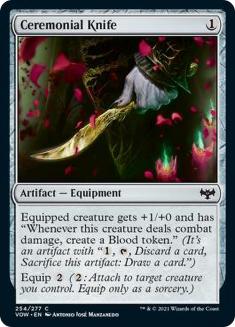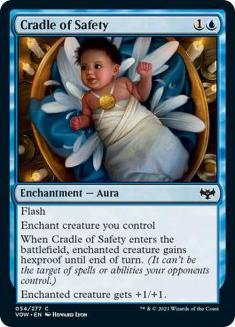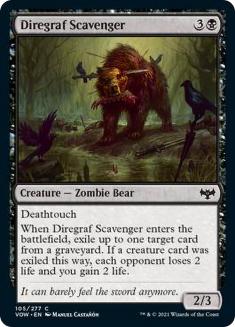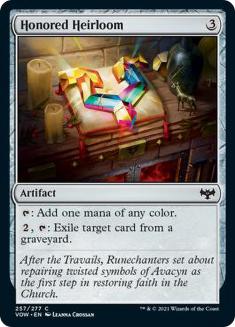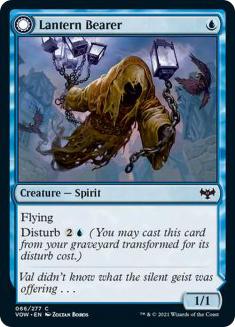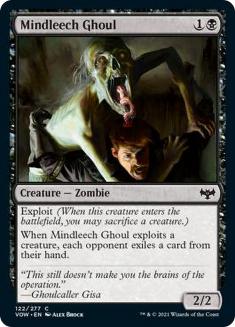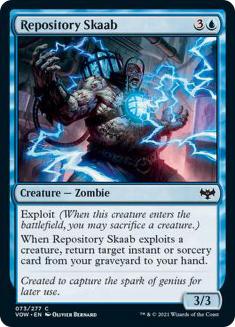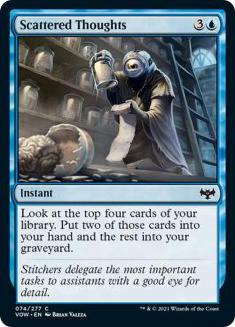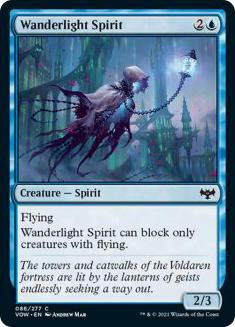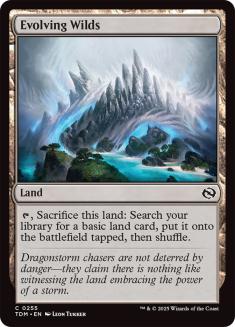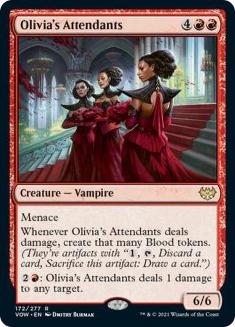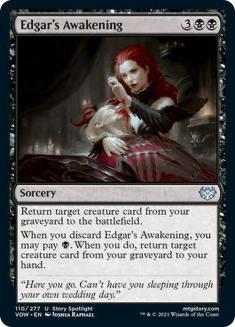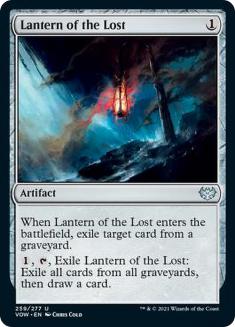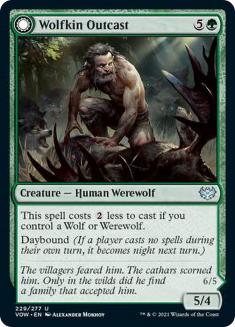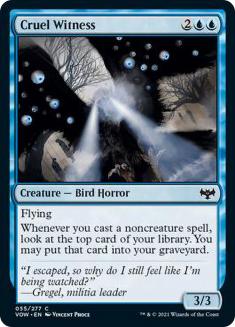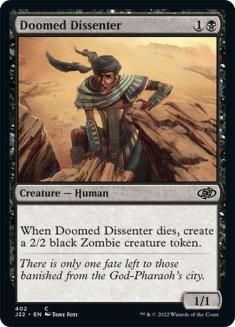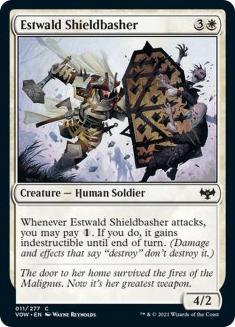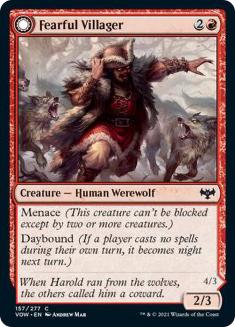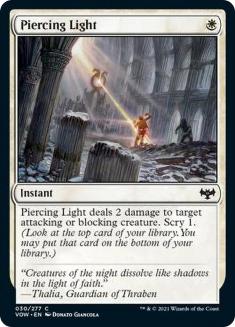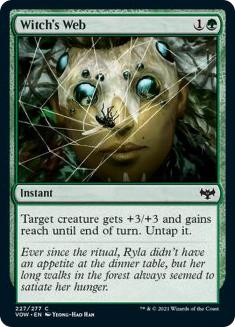By now you’ve probably heard many players call Innistrad: Crimson Vow Draft a “Prince” format; this means a format defined by the rares rather than a format defined by the commons. I’m not a huge fan of that reductive manner of describing formats. That said, the rares in this format are better than usual.
A few are unbeatable, but that’s normal. The real problem is that most rares are better than every common and uncommon, which is not usually the case. This means that nearly every game, you’re going to play against cards that you must answer, otherwise you will lose. So what does this mean for the format as a whole?
1. If you don’t have good rares, you really need to be aggressive.
Unfortunately, the format can be hostile to aggro, which requires important adjustments.
This is a classic solution to “Prince” formats. The best way to beat a deck that has more power than your own is to kill them before they have an opportunity to leverage their most powerful cards. In Innistrad: Crimson Vow, this is a good idea, but it requires a bit more nuance.
The Orzhov lifegain theme bleeds outside of just that color pair. Usually the cards that are good for a lifegain subtheme aren’t good for the other white and/or black decks. But in this format, the enablers are just good cards. Desperate Farmer is fantastic in Dimir deck based around exploit and playable in any black deck. Parasitic Grasp is a first-pickable black removal spell. Diregraf Scavenger is one of the best black commons. And white commons like Traveling Minister, Heron of Hope, and Kindly Ancestor are fantastic in every white deck and problematic for aggro decks.
So, if you don’t have rares, you need to be aggressive, but you need to be aggressive in a manner that doesn’t get shut down by playing against decks reliably starting at 25-30 life. In the last few formats, the best aggressive decks were those that completely skewed their curve down, playing almost no cards above three mana. In this format, that isn’t reasonable. You need to play some hard hitters because too many blockers invalidate two-power creatures, and you need to be able to deal larger chunks of damage over the course of the game. The lack of a Falter effect at common also contributes to this. You can’t just move towards a battlefield stall and eventually facilitate an alpha strike.
Overall, aggressive decks exists, are good, and are necessary to beat rares. But they’re best built without the hyper-aggressive mentality. A great example of an overperformer because of this is Ceremonial Knife. In most Limited formats, that card is just too slow for aggressive decks. However, in this format, it helps your two-power creatures stay relevant while providing card smoothing, which is more relevant when your aggressive deck is playing more expensive cards.
2. Interaction is even more premium than it usually is.
At the beginning of every format, I share this Tweet:
The reason I do is because an old-age Limited heuristic is “removal is removal.” I hate this heuristic. It tells players to just take removal spells, even inefficient ones, because your deck needs to have them. It’s true — removal is important to have access to in nearly every Limited format. But in recent years, it has been much more important to draft a synergistic deck capable of consistently executing a gameplan.
In order to draft decks like that, lowering the value of removal is usually helpful. But given the density of must-answer threats in Innistrad: Crimson Vow, you really cannot draft a successful deck without multiple removal spells. It’s more important to have answers, and ways to find your answers, than it is to have a synergistic deck (at least that’s how I currently feel).
3. The main way you lose in this format is by having a majority of the cards in your deck invalidated by the cards your opponent casts.
This is more subtle, but it informs the two points above, and is the most important thing to realize in order to succeed in Innistrad: Crimson Vow Limited. The reason why aggressive decks have to be built differently is that, if they are built using our usual aggressive heuristics, sequences of commons like curving Kindly Ancestor into Heron of Hope are just game over. They invalidate a large portion of what a usual linear aggressive deck looks like. When this happens, the aggressive player loses unless their library is in a specific order. But this extends further than just aggressive decks.
Consider a Simic self-mill strategy against an Orzhov lifegain strategy. Often the Orzhov deck is going to take the role of the beatdown, and gain life during the process. It’s common for Simic to turn the corner between five and ten life, with Orzhov around 30 life. At this juncture, the Simic deck has a high probability of losing simply due to running out of cards. While the Simic player may not have realized it earlier, their entire self-mill strategy was being invalidated due to the lifegain. It may have required playing differently with this in mind, or building their deck differently in order to not be in this position.
This format has a lot of matchups where specific sequences of commons and uncommons can put an opponent in a position where the majority of the cards in their deck do not matter. This observation strongly informs the proper way to draft and build decks. In this format, the most important question is, “How can I build a deck that minimizes the probability I am put in such a situation?”
The draft we’re about to go into is an odd one. When I finished drafting the deck, I thought it was very bad. But I went 8-0 on Arena (7-1, but the loss was due to not knowing how full control works because I usually play on Magic Online). This got me to reflect on where I went wrong in my evaluation. My conclusion was that this particular deck could play on many axes — it could be quite aggressive and quite controlling. It had the interaction to handle the must-answer threats. It had the tools to mitigate things like running out of cards and getting locked in a battlefield stall. My deck always could do what I wanted it to and my opponents did not have the same luxury.
Pack 1, Pick 5
The Picks So Far:
The Pack:
The Pick:
The first thing to notice about this pack is that there are no black or blue commons, which means I can be 100% confident that a player to my right took a blue common and a black common from this pack. That doesn’t mean I can’t be Dimir, but it’s a very important thing to notice as it will not only impact this decision, but future decisions as well.
This is an interesting spot in a draft, because the direction is quite unclear. I’m not committed to anything, but my pool has the strongest pull to red. However, the red cards in this pack are pretty bad. Kessig Flamebreather can be good in a spells deck with a somewhat aggressive slant, and it’s possible I should consider taking it because wheeling a red spell like Ancestral Anger is pretty likely. However, with cards like Fell Stinger in my pool, I feel like my red deck is most likely not going to be interested in the Flamebreather. The real question is if the probability I draft black is low due to no black cards in this pack. If I were to determine that I shouldn’t draft black, I believe Flamebreather is a more reasonable pick.
Oakshade Stalker, Flourishing Hunter, and Heron-Blessed Geist are solid cards, but they’re quite unexciting. You’ll play them in most decks that can cast them, but that’s not justification to speculate on an additional color. Hence this pick is between Flamebreather and Witness the Future.
I have really high hopes for Witness the Future. While the lack of blue or black commons does provide some amount of pressure towards taking the red card, I think the delta in card quality is just too much. Having access to Witness the Future reduces the probability of losing to two different common ways of strategies being invalidated in this format: running out of cards, and using all your removal spells. I’m usually willing to spend two mana for a card that lets me look at the top four cards of my library and select one. But helping mitigate the most common ways blue decks lose is certainly worth the additional mana. Knowing I have access to this card also helps optimize my decisions for the rest of the draft. Hence, I believe the correct pick is Witness the Future.
The texture of this next pack is complex. The signals from the pack you have seen matter, and nearly every card is a possible option. Take your time with this decision.
Pack 1, Pick 6
The Picks So Far:
The Pack:
The Pick:
Had I taken a green card from the last pack, this pick would be between a green or red card. When I first looked at this pack, I thought that maybe it was telling me I should draft a green deck and take a green card here, but then I realized that the most likely color to pair with green in my pool is red. Gruul would rather have Hungry Ridgewolf than any of these green cards anyway. Unfortunately, none of the other red color pairs appreciate that two-drop, so I’m hesitant to take it.
While the best card in my pool is red, Dimir is also a highly likely direction. Persistent Speciment and Chill of the Grave are at their best in Dimir. However, they’re both filler at best. I’d probably never end up playing more than one copy of either, and it’s likely I’ll be given another opportunity to draft them later in this draft. If I were to pick one, I would take Chill because it’s potentially playable in Izzet, which is a plausible direction at the moment. If it turns out that Chill of the Grave is a card you always play the first copy of in both Izzet and Dimir, it’s probably the correct pick out of this pack. However, I think the best Izzet decks and the best Dimir decks relegate Chill to the sideboard. Given this, I think the correct pick is Gryffwing Cavalry.
Gryffwing Cavalry is a powerful card, but it’s not premium. Aggressive white decks are happy to play the card to provide some reach, but it’s not a card I’m interested in taking early. So why should I even speculate on it here? Given the previous pack containing only Naya commons and not a single black card, I think it’s important to be able to capitalize on drafting Gruul, Selesnya, or Boros if that particular signal keeps flowing.
The red and green cards in this pack aren’t good enough to push me to speculate, but Gryffwing Cavalry is. I’m missing out on mediocre playables for my Dimir or Izzet deck, and I just don’t care about that. If I pass Gryffwing Cavalry, and take Chill of the Grave or Persistent Specimen, I’m effectively closing the door on an opportunity to pivot into an aggressive white deck should the lane present itself. When you add in the fact that I think white is the best color by a reasonable margin, I think it becomes clear that it’s better to give up something of low value in order to have the low probability of capitalizing on something of high value.
Pack 3, Pick 1
The Picks So Far:
The Pack:
The Pick:
All the black cards here have different situations in which they’re optimal given an archetype and/or pool. For example, a Golgari deck with good top-end or a Rakdos deck with lots of Blood tokens and a good curve will take Edgar’s Awakening here. But I’m neither of those decks. A Dimir exploit deck is interested in the right combination of enablers and payoffs. My current pool has a lot of ways to exploit, but not that many good creatures to sacrifice. This leads Doomed Dissenter to be a much better pick than Mindleech Ghoul. But is it better than Cruel Witness?
The texture of this pack and my pool matter a lot to this pick. First, I’m pretty light on threats that are capable of ending the game. I’m almost starved for flyers. While Cruel Witness is usually worth a lot less than Doomed Dissenter in Dimir, it is a lot better with the context of my pool. When you also consider that Doomed Dissenter is quite bad in every non-Dimir black deck, and that the other black cards in this pack are more generally applicable, you realize it’s quite likely that Doomed Dissenter wheels.
I think if there were no other black cards in this pack, Doomed Dissenter would be marginally better to take here than Cruel Witness. However, once you adjust for the probability Doomed Dissenter wheels, Cruel Witness becomes the correct pick. And, as I expected, Doomed Dissenter wheeled, so I got to have my cake and eat it too.

